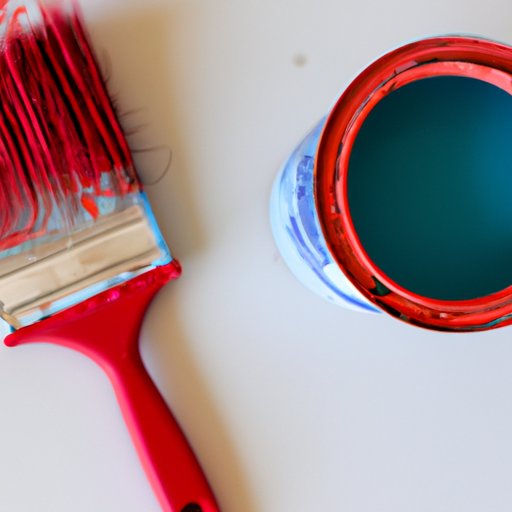
Introduction
If you’re looking to update the look and feel of your home or add a pop of color to a room, painting is a great DIY project that can completely transform a space. Whether you’re a novice painter or a seasoned DIYer, learning how to paint a room can be a fun and rewarding project that can save you money and add value to your home. In this comprehensive guide, we’ll cover everything you need to know about painting a room, from preparing the space to selecting the right paint and tools for the job.
Step-by-Step Guide
Before you start painting, it’s important to properly prepare the room and gather all the necessary tools and materials. Follow these step-by-step instructions to ensure a successful and professional-looking paint job.
Preparing the Room Before Painting
The first step in painting a room is properly preparing the space. This includes removing furniture and fixtures, covering floors and any remaining items with drop cloths, cleaning surfaces and repairing any damages, and applying painter’s tape to edges, corners, and any areas you want to protect from paint.
Choosing the Right Paint and Finish
Next, it’s important to choose the right paint and finish for your project. This includes selecting the perfect color and deciding on a paint finish, such as eggshell, satin, or semi-gloss, based on the room’s purpose and traffic level.
Selecting the Necessary Tools and Materials
Once your room is prepared and you’ve chosen your paint and finish, you’ll need to gather the necessary tools and materials for the job. This includes investing in high-quality brushes, rollers, and other supplies such as a paint tray and stirring stick, as well as considering using a paint sprayer for larger rooms.
How to Cut In, Roll Paint and Use a Paint Sprayer
With your materials and tools ready, it’s time to start painting. Begin by cutting in around edges, corners, and baseboards with a small brush before filling in the remaining surface area with a roller. If using a paint sprayer, follow the manufacturer’s instructions for use and safety.
Tips for a Perfect Finish
To achieve a professional-looking and flawless finish, it’s important to follow a few tips and tricks such as working quickly to avoid overlapping, applying multiple thin coats of paint, and allowing each coat to dry completely before applying the next.
Choosing the Right Paint
Choosing the perfect paint for your project can seem overwhelming with so many brands, colors, and finishes to choose from. To make the process easier, consider factors such as natural lighting, room size, and the emotion and mood you want to convey. It’s also important to understand different paint finishes and popular brands such as Behr, Sherwin-Williams, and Benjamin Moore.
Tools and Materials
When it comes to selecting the necessary tools and materials for painting, investing in good-quality brushes, rollers, and other supplies can make all the difference in achieving a professional-looking finish. Additionally, it’s important to protect floors and furniture with drop cloths and use painter’s tape to avoid any accidental smudging or painting of unwanted areas.
Paint Techniques
To achieve an even and smooth-looking surface, it’s important to master paint techniques such as cutting in around edges and rolling the paint evenly. If using a sprayer, it’s important to carefully follow instructions for use and safety precautions.
Clean-Up and Maintenance
After your painting project is complete, it’s important to properly clean up all materials and tools to ensure they can be reused in the future. Tips for cleaning up include properly storing leftover paint and supplies, washing brushes and rollers with soap and water, and using a proper filter mask for paint sprayers. Additionally, understanding how to maintain painted walls over time, such as regular cleaning and touch-ups, can help the longevity of your project.
Dealing with Challenges
Although painting a room can be a rewarding and fun DIY project, it can also come with some challenges such as dealing with tricky areas like corners and edges, or unexpected paint drips and smudges. To overcome these challenges, consider using painter’s tape to protect surrounding areas and use tools such as a razor blade to gently scrape any unwanted paint.
Design Ideas
Paint can be a great way to add style and interest to a room beyond just covering up walls. Consider adding design elements such as accent walls, painted ceilings, or stencil designs for an added touch of fun and personality.
Conclusion
Painting a room can be a fun and rewarding DIY project that can add value and personality to your home. By following our step-by-step guide, choosing the perfect paint and finish, selecting the right tools and materials, and mastering paint techniques, you’ll be well on your way to creating a beautiful and professional-looking space.




